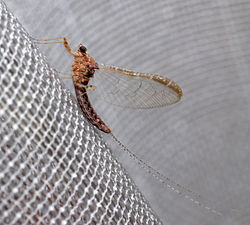Distribution and taxonomy
Cloeon dipterum was first described by Carl Linnaeus in the 2nd edition of his Fauna Suecica . [4] Since then, Cloeon dipterum has been the recipient of unusually many taxonomic synonyms. [2] Alongside new combinations of Linnaeus' original name in different genera ( Ephemera , Chloeon, Cloe and Cloeopsis ), true synonyms include three introduced by Otto Friedrich Müller in 1776 (E. annulatum, E. rufulum and E. dimidiatum), one by William Elford Leach in 1815 (C. pallidum), two by John Curtis in 1834 (C. marmoratum and C. obscurum), three by James Francis Stephens in 1835 (C. cognatum, C. consobrinum and C. virgo), and one each by Jules Pierre Rambur in 1842 (C. affinis), Costa in 1882 (C. apicalis), Bengtsson in 1940 (C. inscriptum) and Jacob in 1969 (C. szegedi).
Cloeon dipterum is widespread across Europe and Asia. In the British Isles, C. dipterum is the commonest mayfly in ponds, with around 40% of all ponds containing C. dipterum, rising to 70% in the south. [9] In 1953, a single female Cloeon dipterum was discovered in Illinois, having not been previously recorded in North America, and was found near Lucas, Ohio in 1960. [10] The species is now known to have a wide distribution in North America. Individuals of C. dipterum from Madeira are now placed in a different species, Cloeon peregrinator . [11]
This page is based on this
Wikipedia article Text is available under the
CC BY-SA 4.0 license; additional terms may apply.
Images, videos and audio are available under their respective licenses.

